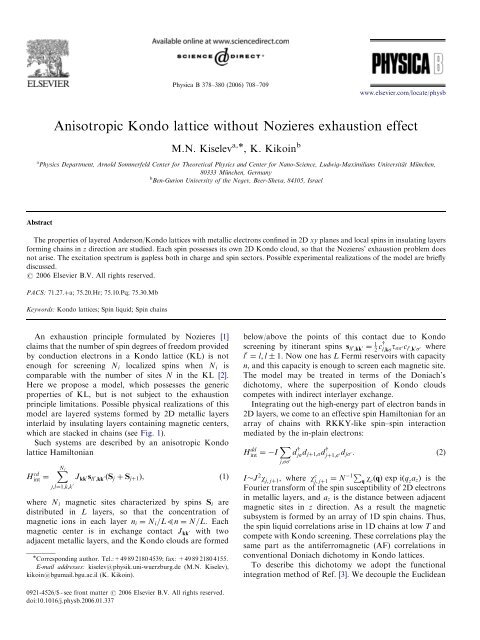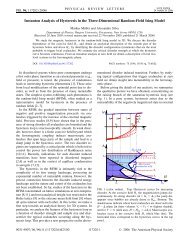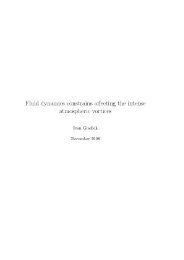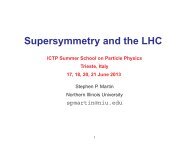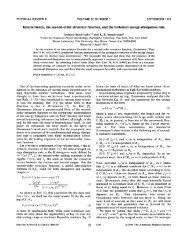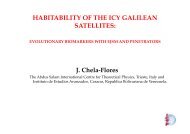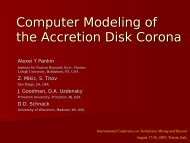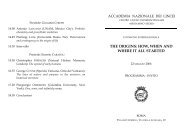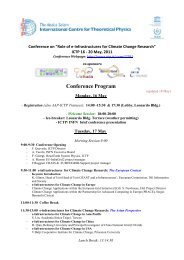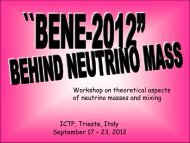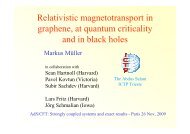Anisotropic Kondo lattice without Nozieres exhaustion effect - ICTP
Anisotropic Kondo lattice without Nozieres exhaustion effect - ICTP
Anisotropic Kondo lattice without Nozieres exhaustion effect - ICTP
You also want an ePaper? Increase the reach of your titles
YUMPU automatically turns print PDFs into web optimized ePapers that Google loves.
Physica B 378–380 (2006) 708–709<br />
<strong>Anisotropic</strong> <strong>Kondo</strong> <strong>lattice</strong> <strong>without</strong> <strong>Nozieres</strong> <strong>exhaustion</strong> <strong>effect</strong><br />
M.N. Kiselev a, , K. Kikoin b<br />
a Physics Department, Arnold Sommerfeld Center for Theoretical Physics and Center for Nano-Science, Ludwig-Maximilians Universität München,<br />
80333 München, Germany<br />
b Ben-Gurion University of the Negev, Beer-Sheva, 84105, Israel<br />
Abstract<br />
The properties of layered Anderson/<strong>Kondo</strong> <strong>lattice</strong>s with metallic electrons confined in 2D xy planes and local spins in insulating layers<br />
forming chains in z direction are studied. Each spin possesses its own 2D <strong>Kondo</strong> cloud, so that the <strong>Nozieres</strong>’ <strong>exhaustion</strong> problem does<br />
not arise. The excitation spectrum is gapless both in charge and spin sectors. Possible experimental realizations of the model are briefly<br />
discussed.<br />
r 2006 Elsevier B.V. All rights reserved.<br />
PACS: 71.27.þa; 75.20.Hr; 75.10.Pq; 75.30.Mb<br />
Keywords: <strong>Kondo</strong> <strong>lattice</strong>s; Spin liquid; Spin chains<br />
An <strong>exhaustion</strong> principle formulated by <strong>Nozieres</strong> [1]<br />
claims that the number of spin degrees of freedom provided<br />
by conduction electrons in a <strong>Kondo</strong> <strong>lattice</strong> (KL) is not<br />
enough for screening Ni localized spins when Ni is<br />
comparable with the number of sites N in the KL [2].<br />
Here we propose a model, which possesses the generic<br />
properties of KL, but is not subject to the <strong>exhaustion</strong><br />
principle limitations. Possible physical realizations of this<br />
model are layered systems formed by 2D metallic layers<br />
interlaid by insulating layers containing magnetic centers,<br />
which are stacked in chains (see Fig. 1).<br />
Such systems are described by an anisotropic <strong>Kondo</strong><br />
<strong>lattice</strong> Hamiltonian<br />
H cd<br />
int ¼<br />
XNi<br />
j;l¼1;k;k 0<br />
Jkk 0s 0<br />
ll ;kk 0ðSj þ Sjþ1Þ, (1)<br />
where Ni magnetic sites characterized by spins Si are<br />
distributed in L layers, so that the concentration of<br />
magnetic ions in each layer ni ¼ Ni=L5n ¼ N=L. Each<br />
magnetic center is in exchange contact J kk 0 with two<br />
adjacent metallic layers, and the <strong>Kondo</strong> clouds are formed<br />
Corresponding author. Tel.:+49 89 2180 4539; fax: +49 89 2180 4155.<br />
E-mail addresses: kiselev@physik.uni-wuerzburg.de (M.N. Kiselev),<br />
kikoin@bgumail.bgu.ac.il (K. Kikoin).<br />
0921-4526/$ - see front matter r 2006 Elsevier B.V. All rights reserved.<br />
doi:10.1016/j.physb.2006.01.337<br />
ARTICLE IN PRESS<br />
below/above the points of this contact due to <strong>Kondo</strong><br />
screening by itinerant spins s 0 0 ll ;kk ¼ 1<br />
2 cy<br />
l;kstss0cl 0 ;k0s0 where<br />
l 0 ¼ l; l 1. Now one has L Fermi reservoirs with capacity<br />
n, and this capacity is enough to screen each magnetic site.<br />
The model may be treated in terms of the Doniach’s<br />
dichotomy, where the superposition of <strong>Kondo</strong> clouds<br />
competes with indirect interlayer exchange.<br />
Integrating out the high-energy part of electron bands in<br />
2D layers, we come to an <strong>effect</strong>ive spin Hamiltonian for an<br />
array of chains with RKKY-like spin–spin interaction<br />
mediated by the in-plain electrons:<br />
H dd<br />
X<br />
int ¼ I d y y<br />
jsdjþ1;sd jþ1;s0djs 0. (2)<br />
j;ss 0<br />
www.elsevier.com/locate/physb<br />
I J2wj; jþ1, where wc j; jþ1 ¼ N 1P<br />
q wcðqÞ exp iðqzazÞ is the<br />
Fourier transform of the spin susceptibility of 2D electrons<br />
in metallic layers, and az is the distance between adjacent<br />
magnetic sites in z direction. As a result the magnetic<br />
subsystem is formed by an array of 1D spin chains. Thus,<br />
the spin liquid correlations arise in 1D chains at low T and<br />
compete with <strong>Kondo</strong> screening. These correlations play the<br />
same part as the antiferromagnetic (AF) correlations in<br />
conventional Doniach dichotomy in <strong>Kondo</strong> <strong>lattice</strong>s.<br />
To describe this dichotomy we adopt the functional<br />
integration method of Ref. [3]. We decouple the Euclidean
(a)<br />
action of the model (1), (2)<br />
Z b<br />
A ¼ dt X<br />
ð¯cG 1<br />
0 c þ ¯dD 1<br />
0 dÞ Hcd int Hdd<br />
" #<br />
int<br />
0<br />
j<br />
layers<br />
spins j j+1<br />
(b)<br />
l l+1<br />
Fig. 1. (a) Layered <strong>lattice</strong> of spatially separated charges in planes and<br />
spins in chains. (b) A fragment of a chain with <strong>Kondo</strong> clouds formed as<br />
‘‘shadows’’ in metallic layers.<br />
by means of the Hubbard–Stratonovich scheme in terms of<br />
the fields Dj;j 1 ! P<br />
sðdyjs dl 1;s þ c:cÞ, fl ! P<br />
ksðcy l 1;ks<br />
ðdj;s þ djþ1;sÞþc:cÞ [3,4]. Here, G 1<br />
0 ¼ qt ð irÞ þ m<br />
and D 1<br />
loc ¼ qt ip=ð2bÞ are the bare inverse single particle<br />
Green functions (GF) for conduction electrons and local<br />
spins, respectively, b ¼ 1=T. The field f describes the<br />
single-site <strong>Kondo</strong> screening and the field D represents the<br />
spinon propagation in the spin liquid regime along the 1D<br />
spin chain with AF coupling. The single occupancy<br />
constraint d y<br />
j" dj" þ d y<br />
j# dj# ¼ 1 is preserved at each site in<br />
the chain by the semi-fermionic transformation [5]. These<br />
two fields resolve the Doniach’s dichotomy, because the<br />
long-range AF order is absent in 1D. We appeal to the<br />
uniform resonance valence bond (RVB) spin liquid state [4]<br />
and treat the spinon modes as fluctuations around the<br />
homogeneous solution in a nn-approximation,<br />
Dj;j 1 ! D u ¯Dwith ¯D j;j 1<br />
2 ðbÞ ¼b 1 R b<br />
0 DðtÞDð tÞ dt. The<br />
action in these terms is<br />
Aeff ¼ X jfl;lðonÞj jl;on<br />
2<br />
!<br />
2<br />
jDj;jþ1ðonÞj<br />
þ þ Tr logðG<br />
~Jlj<br />
I<br />
1<br />
0 Þ<br />
þ Tr logðD 1 ðDÞþG0fl;l fl;l 1 þ c:cÞ ð4Þ<br />
The spin and charge sectors are separated in Aeff.<br />
The last term in Eq. (4) may be represented as a loop<br />
expansion. Analysis of this expansion shows that the KL<br />
remains in a weak <strong>Kondo</strong> screening regime even at T ! 0<br />
since the spin subsystem transforms into a quasi 1D spin<br />
liquid existing in the array of spin chains at T T<br />
8J2 =EF [6], where the spin susceptibility of a chain,<br />
hD þ D i ¯D o¼0<br />
2 , acquires the Pauli form. The screening<br />
results in reduction of the sound velocity of spin excita-<br />
ARTICLE IN PRESS<br />
M.N. Kiselev, K. Kikoin / Physica B 378–380 (2006) 708–709 709<br />
(3)<br />
tions, _v ¼ ~Iaz with ~I ¼ I½1 þ I= ¯D lnð ¯D=T KÞŠ 1 . As to the<br />
in-plane charge excitations, the formation of <strong>Kondo</strong> clouds<br />
is quenched at TbT K, so instead of a coherent Fermi<br />
liquid regime, hf þ f io!0 behaves as a relaxation mode<br />
½ io=G þ aq 2 þ lnð ¯D=T KÞŠ 1<br />
(G; a are the numerical<br />
constants).<br />
The characteristic features of a two-component electron/<br />
spin liquid predetermine the thermodynamics of the KL.<br />
The logarithmic corrections ln 1 ðT =TÞ are expected in<br />
the low-T Pauli-like susceptibility of isotropic spin chains,<br />
whereas the logarithmic corrections to the susceptibility of<br />
charged layers are quenched as ln ¯D=T K. The overdamped<br />
relaxation mode should be seen as a quasielastic peak in w 0.<br />
The 1D spinons contribute to the linear-T term in specific<br />
heat thus mimicking the heavy-fermion behavior, while the<br />
contribution of <strong>Kondo</strong> clouds is frozen at low T.<br />
To conclude, the layered KL possess unique properties<br />
of Fermi liquid behavior in xy plane and spin liquid<br />
behavior in z plane, which are straightforwardly manifested<br />
in the magnetic response. One may point out the<br />
class of layered conducting/magnetic hybrid molecular<br />
solids as an object for the application of above theory.<br />
These crystals are formed by alternating metallic cationic<br />
layers and insulating magnetic anionic layers with radicals<br />
½NðCNÞ 2Š as building blocks and transition metal ions<br />
(e.g., Mn) attached to these radicals as carriers of localized<br />
spins [7]. Organic cations with magnetic ions in such<br />
systems form ordered stacks. The problem is in preparing<br />
metallic layers with large enough Fermi surface to make<br />
<strong>Kondo</strong> screening <strong>effect</strong>ive and to find insulating networks<br />
with large enough distance between the magnetic ions.<br />
This work is supported by SFB-410 and SFB-631<br />
projects, ISF grant, A. Einstein Minerva Center and the<br />
Transnational Access program # RITA-CT-2003-506095<br />
at Weizmann Institute of Sciences.<br />
References<br />
[1] P. <strong>Nozieres</strong>, Ann. Phys. (Paris) 10 (1985) 19;<br />
P. <strong>Nozieres</strong>, Eur. Phys. J. B 6 (1998) 447.<br />
[2] P. Coleman, N. Andrei, JPCM 1 (1989) 4057;<br />
M. Vojta, S. Sachdev, Phys. Rev. Lett. 83 (1999) 3916.<br />
[3] M.N. Kiselev, K. Kikoin, R. Oppermann, Phys. Rev. B 65 (2003)<br />
184410.<br />
[4] L.B. Ioffe, A.I. Larkin, Phys. Rev. B 39 (1989) 8988;<br />
P.A. Lee, N. Nagaosa, Phys. Rev. B 46 (1992) 5621.<br />
[5] V.N. Popov, S.A. Fedotov, Sov. Phys.—JETP 67 (1988) 535;<br />
M.N. Kiselev, R. Oppermann, Phys. Rev. Lett. 85 (2000) 5631.<br />
[6] S. Eggert, I. Affleck, M. Takahashi, Phys. Rev. Lett. 73 (1994) 332.<br />
[7] J.A. Schlueter, U. Geiser, J.L. Manson, J. Phys. (Paris) (IV) 114 (2004)<br />
475.


